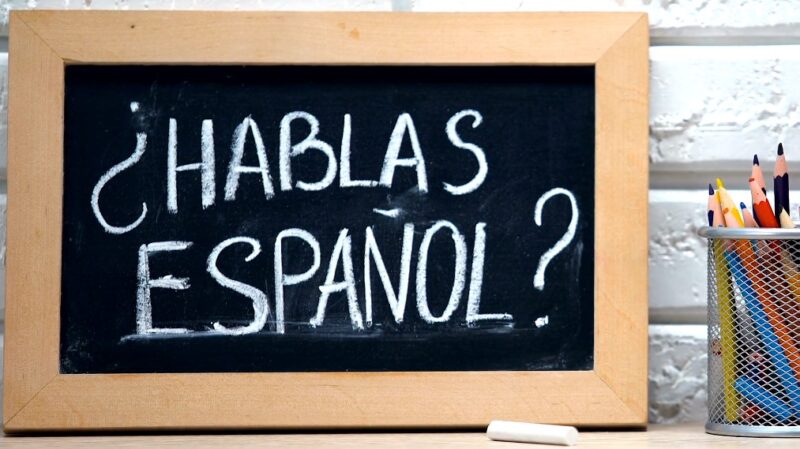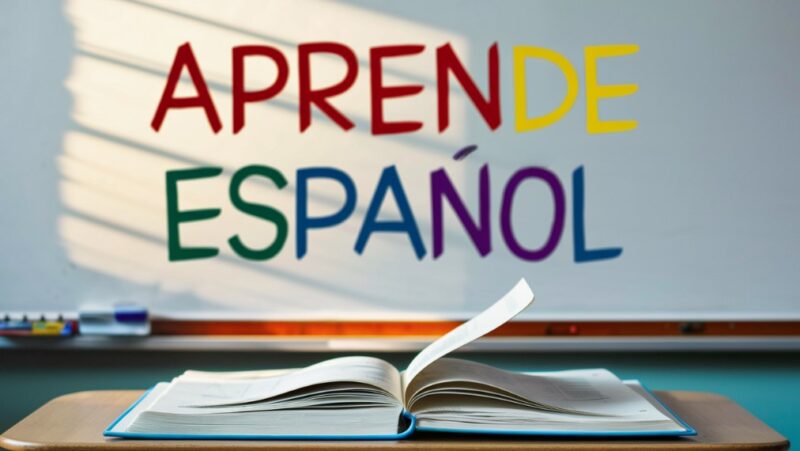Spanish is generally easy to learn, especially for Europeans, because it shares a Latin root with languages like French, Italian, and Portuguese.
This makes many words or phrases sound familiar. With effort and patience, you can quickly reach a good level of Spanish.
But with so many language learning resources available today, it can be hard to know where to begin.
This article will guide beginners on how to start learning Spanish.
Key Takeaways
- Spanish opens doors to travel, culture, and jobs. Super handy and enriching.
- Start with the basics: the alphabet and hello/goodbye. It’s your solid first step.
- A teacher can really speed up your learning with tailored help and motivation.
- Look into Spanish songs and stories. They’re fun ways to get better and soak up the culture.
- Get a grip on grammar basics like verbs and adjectives. It makes talking and understanding smoother.
Why Matters To Learn Spanish?
It’s valid to question the difficulty and time required to learn Spanish.
While learning languages, including Spanish, tends to be easier for children, it’s important to remember that it’s never too late to start.
Learning Spanish offers numerous benefits and advantages.
Here, we focus on the most significant reasons to choose the language of Cervantes as an adult.
Speaking a World Language
Spanish is super popular worldwide, right after English and Mandarin. It’s spoken in loads of places – from Spain and Mexico to Argentina, and even in the US, it’s really common.
If you move to a Spanish-speaking country, you’ll pick up the language super fast!
Hispanic Culture
Picking up Spanish means getting into awesome books, movies, and all sorts of cultural goodies.
Imagine getting the full flavor of works by legends like Cervantes or modern filmmakers like Pedro Almodóvar, in the language they were meant to be enjoyed.
Plus, the movie and TV scene in the Spanish-speaking world is huge, with stars like Antonio Banderas making waves internationally.
Studying Abroad

Knowing Spanish can open doors to studying in cool places like Spain or anywhere in Latin America.
A lot of schools and courses there need you to know Spanish.
It’s your ticket to exploring new cultures and making friends from all over the Hispanic world.
Career with Spanish
Learning Spanish can really boost your career, especially if you’re aiming to work in a global or international setting.
Many jobs list Spanish as a key requirement.
Whether you’re heading to a Spanish-speaking country for work, study, or just a vacation, speaking the language will make a big difference.
Even an intermediate level of Spanish can go a long way.
A Gateway to Other Languages
Spanish is part of the Romance language family, which also includes Portuguese, French, Italian, Romanian (and its Moldovan dialect), Catalan, and Galician.
Once you get to a decent level in Spanish, you’ll find you’ve got a head start on understanding the grammar of these related languages.
Start With Basics

Starting with basic Spanish lessons is key. Learning essentials like the alphabet, introductions, greetings, and names of animals is crucial early on. These basics not only help improve your writing but also boost your listening, reading, and speaking skills in Spanish.
Animals
- Gato: Cat
- Perro: Dog
- Conejo: Rabbit
- Hámster: Hamster
- Pez: Fish
- Ratón: Mouse
- Tortuga: Turtle
- Serpiente: Snake
- Caballo: Horse
- Vaca: Cow
- Oveja: Sheep
- Cabra: Goat
- Pato: Duck
- Gallo: Rooster
No Other Then Alphabet
The Spanish alphabet, also known as the “Abecedario,” is a foundational skill you need to nail down early in your language-learning.
It’s pretty straightforward to memorize, and getting it right is crucial for good spelling.
This alphabet consists of twenty-seven letters. Just like in English, there are 5 vowels in Spanish: “a, e, i, o, u.” These vowels split into two categories: strong vowels (a, e, o) and soft vowels (i, u).
Basic Greetings in Spanish
Let’s go over some essential Spanish greetings:
- Hola (hello, hi): This is the go-to greeting and the most widely used.
- Adiós (bye): The standard way to say goodbye. “Hasta luego” (see you later) is another option when you expect to see the person again soon, though both phrases often mean the same thing in practice.
- Buenos días (Good morning): Use this from sunrise to noon (7:00-13:00).
- Buenas tardes (Good afternoon / Good evening): This greeting works from noon until dusk (13:00-19:00 approximately).
- Buenas noches (Good night): Appropriate after dark (20:00-7:00).
- Hasta mañana (See you tomorrow): If you’re saying goodbye and plan to see the person the next day, this is the phrase to use. It’s commonly used in professional settings, like with coworkers.
Smart Move Is To Start With Teacher

When you’re just starting out, having a teacher by your side can make a huge difference. You’ll get to know Spanish much faster and more thoroughly.
The best part? You don’t even need to step out of your home to find one. Thanks to the internet, there are plenty of online classes that are super interactive.
Why go for a teacher, you ask? It’s like having a personal coach who’s all in on getting you to your goals, keeping you pumped along the way.
Teachers know their stuff when it comes to the nitty-gritty of Spanish and English grammar, and they’re pros at making the complex stuff easy to get.
They’ll spot what you’re good at and where you need a bit more help, crafting a learning plan that’s tailor-made for you.
Listen and Read as Much as You Can

Here’s a tip: put your headphones on and hit the books.
Start with music. Spanish tunes are endless and varied—there’s something for everyone. Find a track or a band that clicks with you and sing along. Don’t stress if you miss a few words here and there. The point is to practice how you say things and maybe learn a few new words along the way.
Reading’s up next. Look into anything related to Spanish-speaking countries that grabs your interest. Books, blogs, stories, phrases—whatever. And hey, it doesn’t all have to be in Spanish. Reading in your own language about the culture, history, food, or just the way of life over there gives you heaps of insights, too.
Getting the Hang of Grammar

Since the rules can be pretty different from one language to another, it might seem daunting. But the good news is the internet is full of resources to practice your Spanish grammar.
Articles
In Spanish, articles must match the noun they’re with in both gender (masculine or feminine) and number (singular or plural). There are two kinds: indefinite articles (un, una, unos, unas) for a general reference, and definite articles (el/los, la/las, lo) for specific ones.
Adjectives
Adjectives in Spanish (like in “la casa naranja” or “el tren rápido”) agree with the noun they describe in gender and number. They’re also used for comparisons, like “la mejor” (the best) or “más lenta que” (slower than).
Verbs
Verbs are a big deal in Spanish. The tricky part for many learners is the vast number of verbs and their forms. Starting with the basics, like the verbs Ser and Estar (to be), Haber and Tener (to have), is key. You’ll also come across gerunds, reflexive verbs, and various moods like the imperative for commands, and more.
Conjugations
Spanish verbs fall into three main conjugation groups you’ll want to get familiar with:
- First Conjugation: Verbs ending in “-ar”.
- Second Conjugation: Verbs ending in “-er”.
- Third Conjugation: Verbs ending in “-ir”.
I am Edward Quin, a teacher and part-time freelance writer specializing in Spanish and English. With a major in these languages, I have a deep grasp of their structures, cultural richness, and literary traditions. My passion for languages inspired me to become a high school teacher, where I motivate students to discover new cultures and languages.
Related Posts:
- Introduction to Beginners German - Your First Steps…
- 50 Basic Spanish Words to Learn for Beginners: Start Today!
- 50 Basic German Words to Learn for Beginners
- Learn to Count in Spanish - Tips and Tricks on How…
- 80 Everyday Spanish Conversational Phrases You Must Learn
- Greetings and Goodbyes to Remember - Let's Learn Spanish

